Vegetarians can get plenty of protein without eating meat. Many plant-based foods are high in this important nutrient. Beans, lentils, tofu, and nuts are all great sources to include when preparing high protein vegetarian meals.
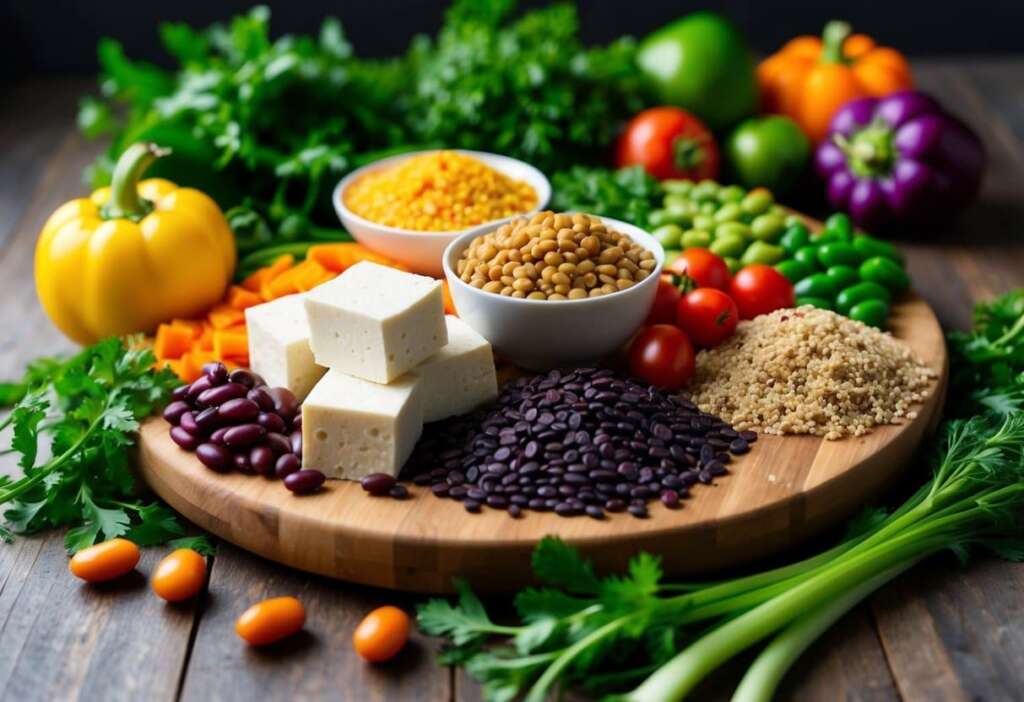
A balanced vegetarian diet can provide 50-80 grams of protein per day. This is enough for most adults. Athletes may need more, but can still meet their needs with plant proteins.
Tasty high-protein veggie meals don’t have to be complicated. A simple lentil soup, chickpea curry, or tofu stir-fry can pack a protein punch. With some planning, vegetarians can easily meet their protein needs while enjoying delicious food.
Diving into Vegetarian Proteins…
Vegetarian protein sources are plentiful and varied. They include beans, lentils, nuts, seeds, and soy products like tofu and tempeh. Many grains and vegetables also contain protein.
Complete proteins have all nine essential amino acids our bodies need. Animal products are complete proteins, but some plant sources are too. Quinoa, buckwheat, and soy are examples of complete vegetarian proteins.
For a balanced diet, vegetarians can combine different plant proteins. This creates complete proteins. Some classic combos are:
- Rice and beans
- Whole grain bread with peanut butter
- Hummus and pita
Protein intake is important for everyone. Most adults need about 0.8 grams of protein per kilogram of body weight daily. Athletes may need more.
Vegetarians can easily meet their protein needs. A varied diet with plenty of legumes, whole grains, and vegetables is key. Adding some eggs or dairy, if eaten, can boost protein intake too.
Meal planning helps ensure adequate protein. Try to include a protein source with each meal and snack. This keeps energy levels steady throughout the day.
Top High-Protein Vegetarian Ingredients
Vegetarian diets can be packed with protein from plant-based sources. These ingredients offer a range of nutrients and can be used in many tasty dishes.
Legumes and Beans
Legumes and beans are protein powerhouses. Lentils have about 18 grams of protein per cup when cooked. They’re quick to make and work well in soups and salads. Black beans and kidney beans each have around 15 grams of protein per cup. They’re great in chilli, burritos, and dips.
Chickpeas, also known as garbanzo beans, packs 14 grams of protein per cup. They’re the main ingredient in hummus and can be roasted for a crunchy snack. Beans are also high in fibre, which aids digestion.
Tofu and Tempeh
Tofu and tempeh are soy-based proteins. Tofu has about 10 grams of protein per half cup. It’s very versatile and can be used in stir-fries, sandwiches, and smoothies. Tofu takes on the flavour of what it’s cooked with, making it a great base for many dishes.
Tempeh offers 15 grams of protein per half cup. It has a firmer texture than tofu and a nutty flavour. Tempeh works well in sandwiches, salads, and as a meat substitute in many recipes.
Nuts and Seeds
Nuts and seeds are protein-rich snacks that also offer healthy fats. Almonds have 6 grams of protein per ounce, while pumpkin seeds have 8 grams. These can be eaten on their own or added to salads and baked goods.
Chia seeds pack 4 grams of protein per ounce. They can be used in puddings, smoothies, and as an egg substitute in baking. Flaxseeds offer 5 grams of protein per ounce and can be ground and added to many dishes.
Dairy Products
For vegetarians who eat dairy, cheese and cottage cheese are good protein sources. Cottage cheese has 14 grams of protein per half cup. It’s low in fat and can be eaten plain or used in both sweet and savoury dishes.
Hard cheeses like cheddar have about 7 grams of protein per ounce. They can be added to sandwiches, salads, and many cooked dishes. Greek yogurt is another high-protein option, with 17 grams per 6-ounce serving.
Grains and Quinoa
Some grains offer decent amounts of protein. Quinoa stands out with 8 grams of protein per cup when cooked. It’s a complete protein, meaning it has all nine essential amino acids. Quinoa can be used in place of rice in many dishes.
Oats have 6 grams of protein per cup. They make a filling breakfast and can be used in baking. Whole wheat pasta offers 7 grams of protein per cup. It can be the base for many vegetarian meals.
Creating Balanced Vegetarian Meals

Balanced vegetarian meals are easy to make with a bit of planning. The key is to include a mix of proteins, carbs, and healthy fats.
Plant-based proteins are crucial for high-protein vegetarian meals. Good sources include beans, lentils, tofu, tempeh, and seitan. These foods pack a protein punch and keep you full.
Whole grains like quinoa, brown rice, and whole wheat pasta add fibre and complex carbs. They give meals staying power and help balance blood sugar levels.
Fruits and veggies are vital for nutrients and fibre. Aim for a colourful mix on your plate. Dark leafy greens like kale and spinach are especially nutritious.
Sample balanced meal ideas:
- Tofu stir-fry with mixed veggies and brown rice
- Lentil soup with whole grain bread and a side salad
- Chickpea curry served over quinoa with steamed broccoli
Don’t forget healthy fats. Add nuts, seeds, or avocado to your meals. They help your body absorb vitamins and keep you satisfied.
Meal prep can make balanced eating easier. Cook big batches of grains and beans to use throughout the week. Keep cut veggies on hand for quick stir-fries or salads.
With these tips, you can create tasty and balanced vegetarian meals that meet your protein needs.
Protein-Packed Breakfast Ideas
Starting your day with a high-protein meal can boost energy and keep you full. These breakfast options pack a protein punch while staying meat-free.
Savoury Oatmeal Variations
Oatmeal isn’t just for sweet toppings. Savoury oatmeal can be a tasty, protein-rich breakfast. Cook steel-cut oats in vegetable broth for extra flavour. Top with a fried egg, sautéed mushrooms, and spinach. Sprinkle with nutritional yeast for a cheese-like taste and added protein.
Another option is to stir in mashed black beans and top with avocado and salsa. This Mexican-inspired version is filling and flavourful. For a Mediterranean twist, mix in sun-dried tomatoes and crumbled feta cheese.
Egg-Based Dishes
Eggs are a vegetarian protein powerhouse. A frittata is an easy way to use eggs for a protein-packed meal. Mix beaten eggs with sautéed veggies like bell peppers and onions. Add some crumbled tofu for extra protein. Cook in an oven-safe pan on the stove, then finish under the broiler.
Baked eggs are another simple option. Crack eggs into ramekins filled with tomato sauce. Add spinach and a sprinkle of cheese. Bake until the whites are set but yolks are still runny. Serve with whole-grain toast for dipping.
Vegetarian Lunch Inspirations
Tasty vegetarian lunches can be quick to make and full of protein. These meals will keep you full and energized all afternoon.
Hearty Bowls
Buddha bowls are a great choice for a filling veggie lunch. Start with a base of quinoa or brown rice. Add roasted chickpeas, cubed tofu, or black beans for protein. Pile on colourful veggies like roasted sweet potato, bell peppers, and kale. Top with a creamy tahini dressing.
Mediterranean bowls are another tasty option. Use couscous as the base. Add falafel, hummus, and Greek yogurt for protein. Include cucumber, tomatoes, and olives. Drizzle with olive oil and lemon juice.
Stuffed sweet potatoes make an easy lunch. Bake a sweet potato and fill it with black beans, corn, and salsa. Top with avocado and a dollop of Greek yogurt. This meal is high in protein and fibre.
Soups and Stews
Lentil soup is a warming lunch packed with protein. Simmer red lentils with carrots, celery, and onions in veggie broth. Add spices like cumin and turmeric for flavour. Serve with a slice of whole-grain bread.
Vegetarian chilli is hearty and protein-rich. Use a mix of beans like kidney, black, and pinto. Add diced tomatoes, bell peppers, and corn. Season with chilli powder and smoked paprika. Top with Greek yogurt and shredded cheese.
Minestrone soup is a veggie-packed option. Start with a tomato broth base. Add white beans, pasta, and lots of veggies like zucchini and spinach. Sprinkle with Parmesan cheese before serving.
Satisfying High-Protein Vegetarian Dinners
Plant-based meals can be protein-packed and delicious. These dinner ideas offer tasty options for vegetarians and meat-eaters alike.
Comfort Foods Reimagined
Mac and cheese get a protein boost with added lentils or chickpeas. This creamy dish becomes more filling and nutritious. Vegetarian meatloaf made from beans, nuts, and grains offers a hearty main course. It’s perfect for cool autumn nights.
Vegan meatballs crafted from tempeh or seitan pair well with whole-grain pasta. They’re just as satisfying as their meaty counterparts. Serve with tomato sauce for a classic meal.
Tofu can be transformed into crispy nuggets or cutlets. Coated in breadcrumbs and baked, they’re a crowd-pleaser. Pair with roasted veggies for a balanced plate.
Exotic Flavours
Tofu curry brings warmth and spice to the dinner table. Firm tofu soaks up rich curry flavours for a protein-rich meal. Serve over brown rice to round out the dish.
Falafel, made from chickpeas or fava beans, offers a taste of the Middle East. These crispy balls are packed with herbs and spices. Stuff them in pita bread with veggies and tahini sauce.
A colourful veggie stir-fry with tofu or tempeh is quick and protein-rich. Use a variety of veggies and a flavourful sauce. Serve over quinoa or brown rice for extra protein.
Lentil dal is a comforting Indian dish full of protein and fibre. It’s easy to make and budget-friendly. Pair with naan bread for a complete meal.
Snacks and Small Bites
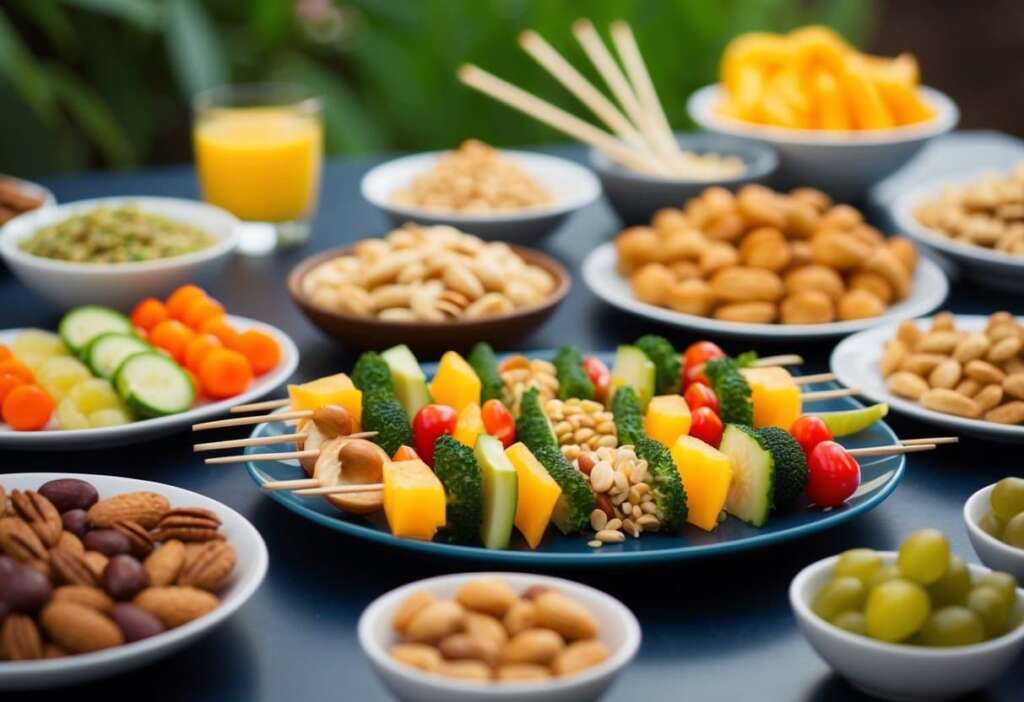
Protein-packed snacks are great for vegetarians looking to boost their intake between meals. Nuts and seeds offer a quick and easy option. A handful of almonds, walnuts, or pumpkin seeds can provide a satisfying crunch and essential nutrients.
Cheese is another protein-rich choice for small bites. Low-fat cottage cheese pairs well with fresh fruit or vegetables. String cheese makes a convenient on-the-go snack.
Legumes can be transformed into tasty snacks. Roasted chickpeas seasoned with spices make a crunchy treat. Hummus serves as a protein-rich dip for raw veggies or whole-grain crackers.
Here are some high-protein vegetarian snack ideas:
- Greek yogurt with berries and a drizzle of honey
- Chia seed pudding topped with sliced almonds
- Edamame pods sprinkled with sea salt
- Hard-boiled eggs with a dash of pepper
- Apple slices spread with almond butter
For a savoury option, try making your own trail mix. Combine nuts, seeds, and dried fruit for a balanced snack. This mix travels well and stays fresh for days.
Protein bars can be a quick fix, but watch out for added sugars. Look for bars with natural ingredients and at least 10 grams of protein per serving.
Strategies for Maintaining High Protein Intake
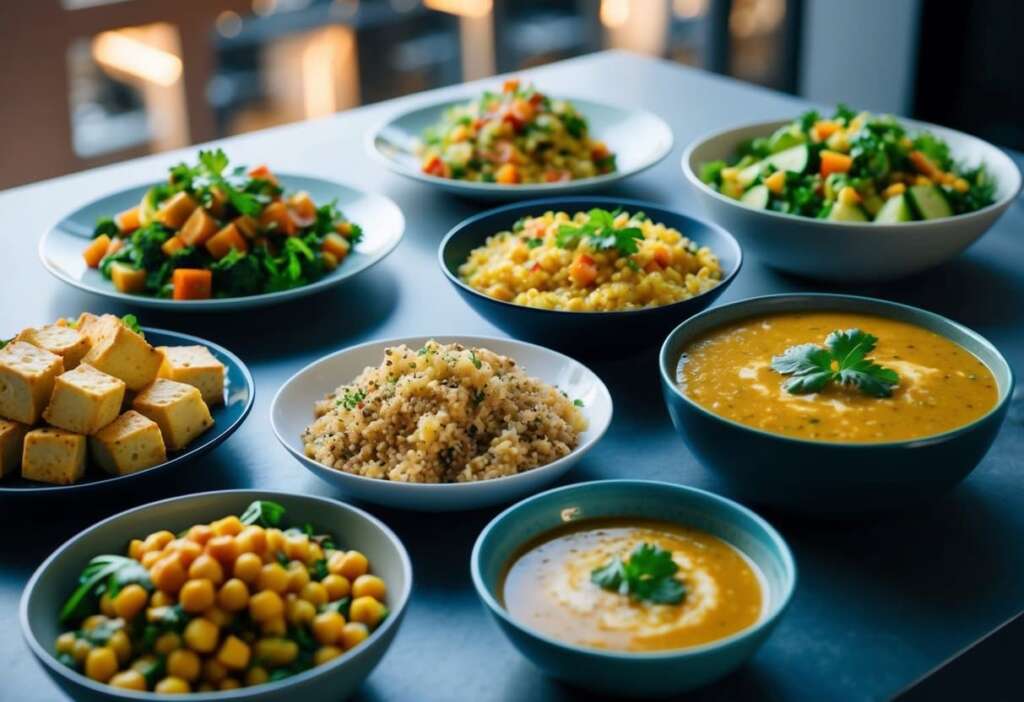
Eating enough protein is key for vegetarians. It’s easy to do with the right plan.
Plant-based protein sources are plentiful. Beans, lentils, and peas are protein powerhouses. They’re cheap and versatile too.
White beans are a great choice. They pack a protein punch and blend well into many dishes.
Nuts and seeds offer protein and healthy fats. Almonds, pumpkin seeds, and chia seeds are top picks.
Soy products like tofu and tempeh are protein-rich. They take on flavours well, making them perfect for many recipes.
Whole grains contribute to protein intake. Quinoa and oats are standouts.
Veggies can boost protein too. Artichokes, for example, have more protein than many other vegetables.
Meal planning helps ensure adequate protein. Aim to include a protein source at each meal.
Snacks can help meet protein goals. Try hummus with veggies or a handful of nuts.
Protein powders can supplement intake if needed. Look for plant-based options like pea or hemp protein.
Tracking food intake can help. It shows if protein goals are being met.
Integrating Plant-Based Proteins into Traditional Dishes
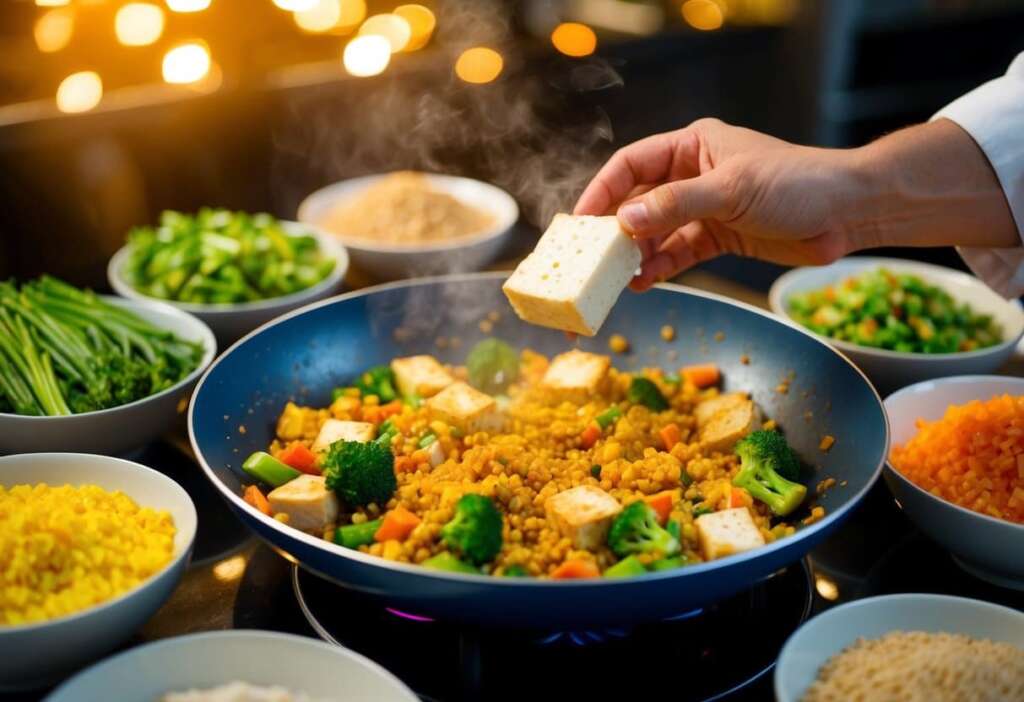
Adding vegetarian protein to classic meals is easy and tasty. Many dishes can be made meatless with a few simple swaps.
Spaghetti Bolognese is a great dish to start with. Replace ground beef with lentils or textured vegetable protein (TVP) in the tomato sauce. These plant-based proteins soak up the flavours and create a similar texture to meat.
Tacos are another fun option for high-protein vegetarian meals. Use black beans or crumbled tofu instead of ground meat. Add spices like cumin and chilli powder for an authentic taste.
Shepherd’s pie can be made with lentils or mushrooms in place of lamb. Top with mashed potatoes for a comforting meal packed with vegetarian sources of protein.
Here’s a quick list of plant-based proteins to try in your favourite dishes:
• Beans (black, kidney, chickpeas) • Lentils (red, green, brown) • Tofu or tempeh • Seitan (wheat protein) • Quinoa
Experiment with these ingredients to boost the protein in your meals. You’ll find that many traditional recipes taste just as good – or even better – with plant-based proteins.
Meal Planning and Prep for Success
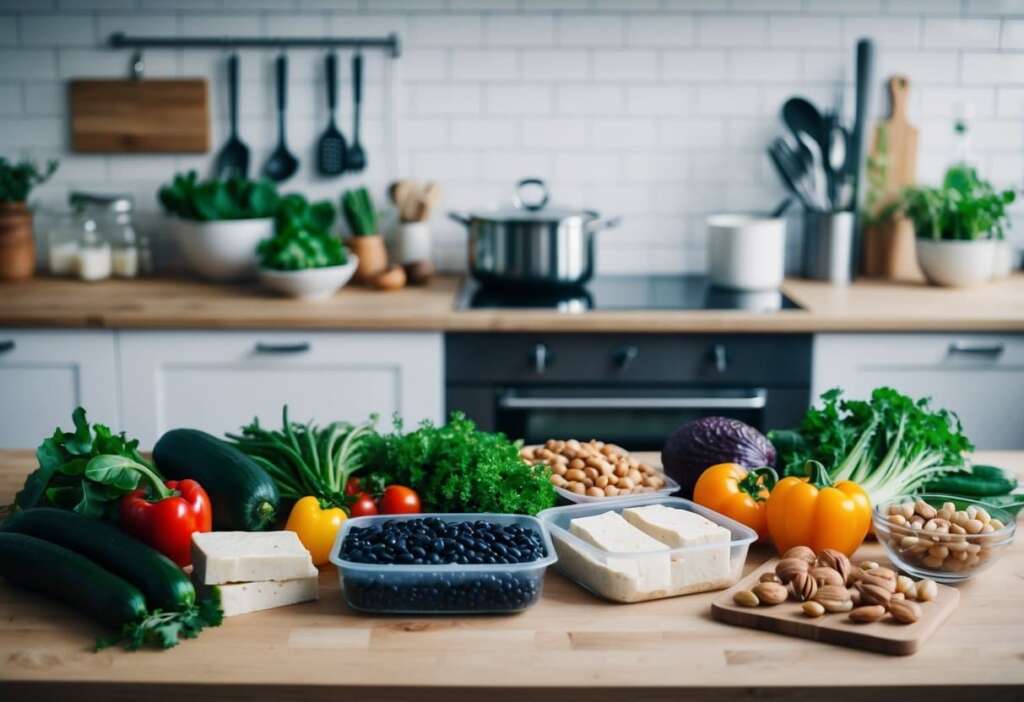
Planning high-protein vegetarian meals ahead of time makes it easier to eat well all week. Start by choosing 3-4 recipes to make. Look for dishes that use similar ingredients to save money and reduce waste.
Make a shopping list based on the recipes. Include protein-rich foods like beans, lentils, tofu, and eggs. Don’t forget to add lots of veggies and whole grains too.
Prep tips: • Cook big batches of grains and beans on the weekend • Chop veggies in advance and store them in containers • Make sauces and dressings to use throughout the week
Consider prepping full meals to reheat later. Veggie chilli, lentil curry, and bean burritos all freeze well. Store individual portions for quick lunches or dinners.
Keep snacks on hand too. Hummus with veggies, Greek yogurt with fruit, or trail mix with nuts are good options. These provide protein boosts between meals.
With a bit of planning, it’s easy to enjoy tasty high-protein vegetarian meals every day. A little prep work saves time and stress during busy weekdays.
Frequently Asked Questions
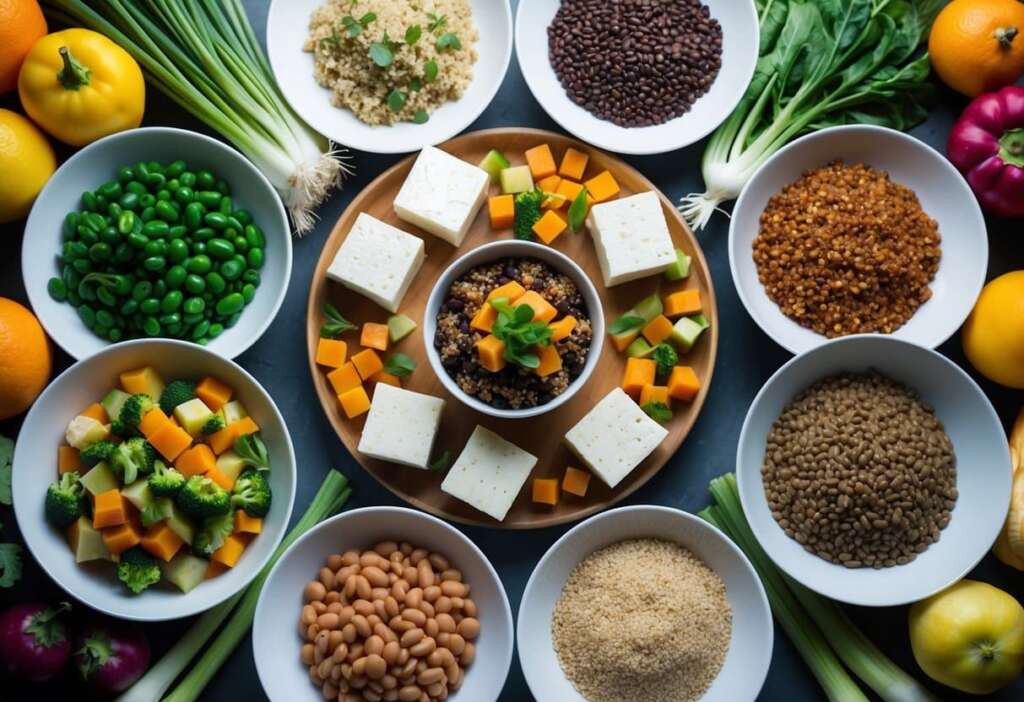
Vegetarians have many options for high-protein meals. These can support weight loss, muscle building, and quick meal prep. Let’s look at some common questions about protein-rich vegetarian eating.
What are some effective vegetarian dishes for weight loss that are high in protein?
Lentil soup is a filling, low-calorie option packed with protein. Greek yogurt parfaits with nuts and berries offer protein and fibre. Tofu stir-fries with lots of veggies are also great for weight loss.
Could you suggest some Indian vegetarian recipes that are high in protein?
Chana masala, made with chickpeas, is protein-rich and tasty. Dal makhani uses lentils and kidney beans for a protein boost. Paneer tikka offers a good amount of protein from cheese cubes marinated in spices.
What vegetarian meals can help with muscle building due to their high protein content?
Quinoa bowls with roasted veggies and tofu are great for muscles. Bean and cheese burritos pack a protein punch. Tempeh sandwiches with whole grain bread also support muscle growth.
What are some quick vegetarian meals that are also high in protein?
Protein smoothies with plant-based powder are fast and easy. Hummus and veggie wraps take minutes to make. Hard-boiled eggs with whole-grain toast offer quick protein too.
How can vegetarians ensure they’re getting at least 30 grams of protein per meal?
Mixing protein sources helps reach this goal. Try tofu scramble with beans and cheese. Add nuts and seeds to salads or oatmeal. Use protein-rich pasta made from lentils or beans.
What meal prep strategies can vegetarians use to maintain high protein intake?
Cook big batches of beans or lentils for the week. Pre-cut tofu and marinate it for quick cooking. Make egg muffins or frittatas to reheat later. Portion out nuts and seeds for easy snacking.

